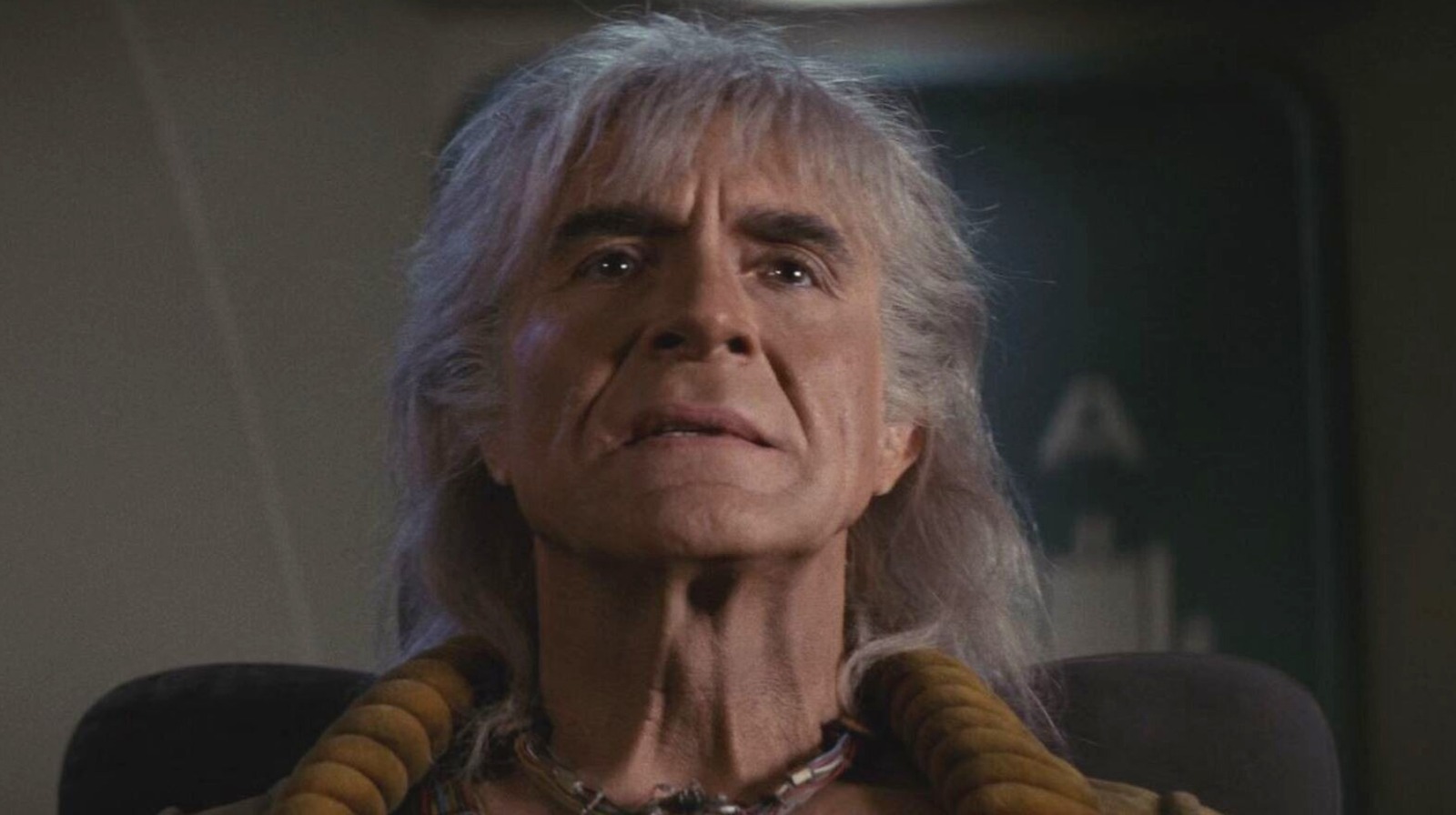
The Ending Of Star Trek II: The Wrath Of Khan Explained – Looper
“Star Trek II: The Wrath of Khan” is one of the most iconic movies in the indispensable “Star Trek” franchise. It has a wonderful cast, stellar performances, and an excellent action-packed story. If that wasn’t enough, it also delivers a truly unforgettable ending by providing a heartfelt goodbye between the two main characters of the original “Star Trek” series. The classic ending, in which Spock sacrifices his life to give the U.S.S. Enterprise a chance at survival, is remembered as one of the saddest and most memorable moments in science fiction.
Regardless of its quality, however, “Star Trek II: The Wrath of Khan” isn’t free of apparent inconsistencies and confusing ideas. For example, Kirk’s nemesis — the genetically enhanced Khan Noonien Singh — is supposed to have a superior intellect, yet he’s repeatedly outsmarted by Kirk. The man in command of the Enterprise is also presented as a righteous leader, and yet he is famous for cheating in one of the Federation Academy’s most important assessments. The story also includes complex themes related to revenge and the impact scientific research can have on people. Below we provide an analysis of this iconic movie. Here’s the ending of “Star Trek II: The Wrath of Khan” explained.
The plot of ‘Star Trek II: The Wrath of Khan’
 Paramount Pictures
Paramount Pictures
The first movie in the franchise, “Star Trek: The Motion Picture,” doesn’t deliver the level of action some fans may have expected. Its sequel, “Star Trek II: The Wrath of Khan,” initially threatens to have a similarly slow pace. At its onset, the U.S.S. Enterprise and its aging crew, with Spock as captain, are relegated to training new cadets through simulations and training missions. James T. Kirk, on the other hand, has been granted the rank of admiral but occupies his time as a retiree who occasionally supervises cadets’ assessments and inspects ships.
After joining his old crew for their training mission, however, the U.S.S. Enterprise receives an unclear message from an old friend. Carol Marcus is a scientist developing Genesis, a technology capable of instantly changing the chemistry of a dead planet to provide it with its own biosphere. Marcus demands that Kirk explain why he has ordered to take over Genesis, which awakens her fear of the technology being used as a weapon. Unknown to the crew of the Enterprise, though, their old enemy Khan Noonien Singh, a genetically engineered super-soldier, has taken over the ship Reliant and is setting a trap to finally get revenge on Kirk.
What happens at the end of ‘Star Trek II: The Wrath of Khan’
 Paramount Pictures
Paramount Pictures
As with most major “Star Trek” stories, the crew of the Enterprise faces a seemingly unbeatable opponent and has to rely on their wits to defeat him. After their ship is badly damaged during an ambush, Kirk launches a counterattack on Khan’s ship, then enters the depths of the planet where the Genesis was tested and asks the Enterprise to leave if they don’t hear back from him. However, they soon discover that Khan is listening to their communications and intends to use his knowledge of their plans against them.
Nevertheless, Khan is defeated by Kirk’s experience. First, Kirk reveals that he was aware of Khan’s surveillance and that the Enterprise hasn’t left. He then lures Khan’s ship, which is in a better condition than the Enterprise, to follow them into a nebula where a storm taking place within will block most sensors and shields, leveling the playing field. The Enterprise launches a sneak attack on the Reliant, leaving the agonized Khan to activate the Genesis, believing that Kirk and his crew won’t be able to leave the zone of impact on time. In what is considered one of the most memorable moments in “Star Trek,” Spock leaves the bridge and heads to the engine room where he enters the core of the ship and repairs it, allowing the crew of the Enterprise to escape the explosion, but receiving a deathly dose of radiation in exchange.
Khan represents Kirk’s dreaded Kobayashi Maru scenario
 Paramount Pictures
Paramount Pictures
In the first scene of the movie, we see a new cadet commanding a bridge in a simulation. She is given the option to rescue the fleet of a damaged ship by entering a Klingon neutral zone or leaving them to die. She chooses the first option and gets attacked in response. The mission is designed to test how cadets react to a scenario where no victory is possible. Only Kirk manages to overcome the challenge during his training days by reprogramming the simulator. As he puts it later, he doesn’t like to lose. Sadly, this also means the experienced admiral has never faced true loss … until now.
During his confrontations with Khan, Kirk manages to not only survive but defeat the vengeful super-soldier. This doesn’t mean he leaves completely unscathed. His ship is badly damaged, he loses several crew members, watches helplessly as Khan transports the Genesis to his ship, and realizes he might not be able to escape the explosion of the device when Khan activates it before dying. Kirk only escapes thanks to Spock’s sacrifice. After a heartfelt goodbye and funeral, Kirk realizes that even though he has faced death several times, he’s never had to experience the loss of someone this close to him. Thus, he finally confronts the no-win scenario from the Kobayashi Maru.
The possibilities of Genesis and Kirk’s newly discovered son
 Paramount Pictures
Paramount Pictures
James T. Kirk has lived most of his life traveling across the universe. And yet, this movie finds him living the life of a retired officer. He spends his days in a beautiful house, being visited by old friends, and only stepping into a ship to perform inspections. Kirk’s life seems like a suitable reward for his achievements, but as McCoy reminds him, he should get back on a ship before he truly becomes an old man and can no longer do so.
When the Enterprise receives a call from the space station working on Genesis, the decision is made to investigate. However, since Kirk is the senior officer, he is granted command over the bridge. Once again, he is in control of the Enterprise, exploring the unknown, but his trip is filled with surprises and traps.
On the planet orbited by the space station, Kirk meets an old friend who shows him the power of Genesis. In an underground facility, the device is able to fill an enormous cave with life in only a few minutes. With a sight that reflects paradise and the revelation that David, Dr. Marcus’ son, is Kirk’s, the admiral starts to feel differently. With the amazing power of Genesis and the possibility of having a father-son relationship, Kirk starts feeling young for the first time in years.
Khan’s superior intellect is no match for his ego
 Paramount Pictures
Paramount Pictures
Once Chekov and Terrell explore Ceti Alpha VI, they expect to discover a planet with no life. But as soon as Chekov realizes they have accidentally landed on the planet where Khan Noonien Singh and his team were abandoned, he reacts with horror and tries to escape the doomed planet. The former Enterprise crew member’s reaction is justified; Khan is a super-soldier, genetically engineered on Earth with superior physical and intellectual capabilities in order to make him the perfect conqueror. But he also has a fatal flaw — an enormous ego.
Khan is clever and persistent, but completely controlled by his emotions. He uses Chekov, the Reliant, and Genesis solely to draw out Kirk. When he launches his ambush, he assumes he has completely defeated his old enemy, which gives Kirk the chance to use his knowledge of Federation ships to launch a counterattack. When Kirk taunts him and departs from the nebula, Khan follows despite being warned that this is a clear trap. In the end, Khan’s natural confidence brings about his demise at the hands of an admiral who has developed a keen sense of strategy thanks to his decades of struggles. As the crew states, Khan is smart but inexperienced.
The death of Spock was supposed to be permanent
 Paramount Pictures
Paramount Pictures
The original cast of “Star Trek” appeared in a handful of films, starting with 1979’s “Star Trek: The Motion Picture” and concluding with 1991’s “Star Trek VI: The Undiscovered Country.” During this period, Spock was a regular member of the cast, except for his absence between the end of “Star Trek: The Wrath of Khan” and the end of “Star Trek III: The Search for Spock.” Under these circumstances, it would appear that the death of Spock was nothing but a marketing trick intended to draw more fans to theaters, but members of the cast draw a very different picture.
William Shatner, for example, explained to Nerdist that back in the day, each movie was filmed as if it was the last one — props and sets were typically destroyed under the assumption that they wouldn’t be needed again. This makes it clear that the intention to kill Spock was, at the time, a final decision that wasn’t changed until the possibility of a third movie became real. Nicholas Meyer, the director, corroborated this in an interview with Yahoo by explaining that, despite the different scripts written for the sequel, they all had one thing in common: Spock dies. This was a requirement demanded by Leonard Nimoy. After “Star Trek II” became a success, the studio came back to Nimoy with a sufficiently appealing offer, and he agreed to return. But as far as anyone knew at the time, Spock was dead as a doornail.
Khan’s intention to get revenge on Kirk became true
 Paramount Pictures
Paramount Pictures
From his first confrontation with Kirk, it’s evident that Khan’s worst flaw is his lack of control over his emotions. His overconfidence after ambushing Kirk earns Kirk a counterattack; Khan’s presumption that he has tricked Kirk by using a mind control technique on Chekov and Terrell leads him to think that the Enterprise has abandoned Kirk when it hasn’t; and his pursuit of the ship into the nebula leads him to be killed by a devastating surprise attack. And yet, the promise Khan makes to Kirk when Kirk looks stranded — that he will continue to hurt him — ultimately becomes true.
The Enterprise has, of course, suffered several casualties by that point. But none of them were people personally close to Kirk. After the admiral forces Khan into a battle in the nebula, Khan’s crew is killed, his ship is mostly disabled, and he is fatally wounded. Is at this point where Kirk makes the same mistake Khan constantly fell for — he acts with excessive confidence. With his last breath, Khan activates the Genesis, which generates an explosion capable of destroying the Enterprise. The Enterprise manages to escape, but the situation hurts Kirk quite a lot by forcing Spock to sacrifice himself to fix the ship’s engine.
The director’s approach and the actors’ performance made the death scene
 Paramount Pictures
Paramount Pictures
The ending of “Star Trek: The Wrath of Khan” is one of the most iconic and bittersweet in the franchise. Fans are constantly quoting the last words spoken by Spock and Kirk, and the moment is even reimagined for the second movie of J.J. Abram’s “Star Trek” reboot series. This isn’t surprising considering how emotionally moving the scene is, especially if we take into account that the actors had been working together as Kirk and Spock for many years. In fact, as the director explains, the crew was in tears when they witnessed the last goodbye between the two legendary characters.
With such a legendary ending, the film became a source of discussion and analysis that’s continued for years. Speaking to Yahoo, Meyer mentioned that his technique to get Shatner to perform was to make him repeat his scenes so many times that he would stop trying to act and provide more honest takes. Meyer also refers to the level of preparation both Shatner and Nimoy brought to the scene, and how they immersed themselves in the roles, providing a performance that reflects the time they had spent together.
Shatner believes the death of Spock helped get Nimoy the director’s chair
 Frazer Harrison/Getty Images
Frazer Harrison/Getty Images
As popular as the original “Star Trek” series was and remains, this didn’t save it from being canceled after only three seasons. While most fans and cast members may have felt a deep sense of disappointment, one main cast member probably felt a little bit of relief. It’s well-known that the success of “Star Trek” made Leonard Nimoy fear being typecast as an alien character in science fiction shows. He got roles in popular series like “Mission: Impossible” while also working on plays. But every other job was overshadowed by his performance as Spock.
Nimoy got tired of people identifying him with Spock. He even went as far as writing a book titled “I Am Not Spock.” Despite this, he accepted the role one more time when the franchise made the jump into feature films. After “Star Trek: The Motion Picture” though, he decided to abandon the role, only agreeing to participate in the sequel on the condition that Spock dies in the film. William Shatner, however, has an interesting theory about this requirement. In a chat with USA Today, he argued that, after the popularity of the sequel, Nimoy used Spock’s death for leverage in a bid to get the director chair. In the end, he appears to have succeeded, as he directed both “Star Trek III: The Search for Spock,” and “Star Trek IV: The Voyage Home,” productions that allowed him to start a career as a director.
‘Wrath of Khan’ set the conditions for the next Star Trek movie
 Paramount Pictures
Paramount Pictures
The main theme of “Star Trek: The Wrath of Khan” revolves around how revenge can be a self-destructive journey. However, the script doesn’t completely forget that this is a science fiction franchise and introduces a thought-provoking concept — scientists have developed a device that can trigger a chemical chain reaction capable of creating a biosphere around a deserted planet. The details of this accomplishment are not discussed, but the power is made evident when the device explodes and leaves a surrounding planet with overgrown vegetation.
Interestingly, the crew of the Enterprise chooses this location as the place to leave Spock’s body. The reason may be that it’s the location closest to his most heroic act, but it also conveniently opens the door for Spock’s revival due to the planet’s miraculous capacity to create life. However, the biggest evidence of the intention to revive Spock is probably the fact that, right before entering the core of the ship, he performs a mind meld on McCoy, suggesting that he might have stored his memories with the doctor. That becomes an important part of the sequel when Spock’s body returns and retrieves his memories from McCoy.
Gene Roddenberry had a different idea for the ending
 Paramount Pictures
Paramount Pictures
Many stories and scripts were created for the sequel to “Star Trek: The Motion Picture.” Each of these stories was different from the others, so when Nicholas Meyer was brought to the project, he decided to pick every element he liked from each version and try to put together a good story. Each version differed significantly. In one iteration, Spock dies very early in the movie; in others he dies in the end, and in Gene Roddenberry’s version, the crew would have traveled back in time.
Many science fiction stories play with time travel, and “Star Trek” would eventually have a movie that revolves around such a concept in “Star Trek IV: The Voyage Home.” However, there were specific aspects of the story that made Roddenberry’s proposal highly unpopular with just about everyone who read it. To be more specific, at one point in the movie, the crew goes back in time and find themselves planning the assassination of J.F.K. in order to restore their timeline. Needless to say, the studio executives weren’t very happy with the idea and ended up scrapping it.











































































